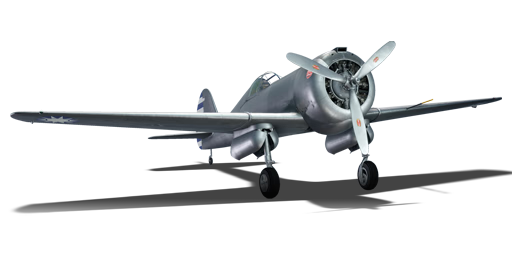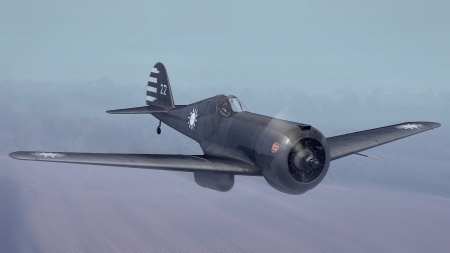CW-21
Contents
Description
The CW-21 is a rank Chinese fighter
with a battle rating of (AB), (RB), and (SB). It was introduced in Update 1.91 "Night Vision".
A relatively untested aircraft so far, the CW-21 will be a surprise to pilots stepping into the Chinese tech tree. The first few Chinese aircraft can be a struggle to fly and master, however, the CW-21 picks up the slack the moment it gets airborne. While sitting on the airfield, you will notice quickly that this fighter is a relatively small monoplane fighter, akin to a P-26. During the take-off roll, you instantly notice the extremely short take-off span, as it begins lifting off when reaching 145 kph (90 mph). While speaking of speed, the CW will quickly outrun and outpace the competition, leading to a lot of the primary biplane opposition simply being unable to catch up and get within firing distance.
When it comes to firepower, this bird has talons and easily uses its 2 x.50 calibre M2s plus 4 x.30 calibre M1919s to decimate any plane that crosses its path. While it can punch hard with its guns, you might be more than surprised to know that the CW can take a hit too. The wings, strong as they are, are the most durable flight construction in the game and able to take round after round, hit after hit from the vast multitude of armaments from contemporary aircraft it comes up against, ranging from the weak Japanese 7.7 mm, to the heavy impacting 20 mm ShvaK cannons fielded by the Soviets. Not that you'll be getting hit much, as a competent pilot will tell you manoeuvrability is key and an agile plane it is. The turn time is easily competitive with most if not all biplanes, except possibly the I-153 that intrinsically trumps all other aircraft when it comes to turning and turn fighting. All in all, the CW-21 is a powerhouse, ready to zoom in, shred and ignite the enemy and shrug off all incoming fire.
General info
Flight performance
Describe how the aircraft behaves in the air. Speed, manoeuvrability, acceleration and allowable loads - these are the most important characteristics of the vehicle.
| Characteristics | |||||||
|---|---|---|---|---|---|---|---|
| Stock | |||||||
| Max Speed (km/h at 3,700 m) |
Max altitude (meters) |
Turn time (seconds) |
Rate of climb (meters/second) |
Take-off run (meters) | |||
| AB | RB | AB | RB | AB | RB | ||
| 480 | 465 | 14.2 | 15.0 | 13.4 | 13.4 | 343 | |
| Upgraded | |||||||
| Max Speed (km/h at 3,700 m) |
Max altitude (meters) |
Turn time (seconds) |
Rate of climb (meters/second) |
Take-off run (meters) | |||
| AB | RB | AB | RB | AB | RB | ||
| ??? | 505 | ??.? | 14.0 | ??.? | 18.2 | 343 | |
Details
| Features | ||||
|---|---|---|---|---|
| Combat flaps | Take-off flaps | Landing flaps | Air brakes | Arrestor gear |
| ✓ | ✓ | ✓ | X | X |
| Limits | ||||
|---|---|---|---|---|
| Wing-break speed (km/h) |
Gear limit (km/h) |
Combat flaps (km/h) |
Max Static G | |
| + | - | |||
| 380 | ~10 | ~5 | ||
| Optimal velocities | |||
|---|---|---|---|
| Ailerons (km/h) |
Rudder (km/h) |
Elevators (km/h) |
Radiator (km/h) |
| < 280 | < 260 | < 450 | > 250 |
| Compressor (RB/SB) | ||
|---|---|---|
| Setting 1 | ||
| Optimal altitude | 100% Engine power | WEP Engine power |
| 1,829 m | 850 hp | 1,000 hp |
| Setting 2 | ||
| Optimal altitude | 100% Engine power | WEP Engine power |
| 4,633 m | 750 hp | 882 hp |
Survivability and armour
Examine the survivability of the aircraft. Note how vulnerable the structure is and how secure the pilot is, whether the fuel tanks are armoured, etc. Describe the armour, if there is any, and also mention the vulnerability of other critical aircraft systems.
Armaments
Offensive armament
The CW-21 is armed with:
- 2 x 12.7 mm Browning M2 machine guns, nose-mounted (200 rpg = 400 total)
- 2 x 7.62 mm Browning machine guns, nose-mounted (500 rpg = 1,000 total)
Usage in battles
The CW-21 should be mainly used as a fighter. Excelling in turns, acceleration, and hard-hitting guns, it is very easy to dogfight other planes at its battle rating. Your main composition will sometimes be bi-planes and some bi-planes can out turn you. However, the CW-21 against monoplanes is where it really shines. It can easily out turn other planes like the He-100 or even the He-112 which is crucial in a dogfight. The CW-21 does not have any CAS potential other than knocking out light targets like AAA and armoured vehicles, so the main targets will be other planes.
Manual Engine Control
| MEC elements | ||||||
|---|---|---|---|---|---|---|
| Mixer | Pitch | Radiator | Supercharger | Turbocharger | ||
| Oil | Water | Type | ||||
| Controllable | Controllable Not auto controlled |
Not controllable Not auto controlled |
Not controllable Not auto controlled |
Separate | Controllable 2 gears |
Not controllable |
Modules
| Tier | Flight performance | Survivability | Weaponry | ||
|---|---|---|---|---|---|
| I | Fuselage repair | Radiator | Offensive 7 mm | ||
| II | Compressor | Airframe | Offensive 12 mm | ||
| III | Wings repair | Engine | New 7 mm MGs | ||
| IV | Engine injection | Cover | New 12 mm MGs | ||
Pros and cons
Pros:
- Respectable firepower for the rank
- Turn rate is on par with the early Spitfires and even A6Ms
- .50 calibre API at this rank is very dangerous
- Mediocre energy retention
- Climb rate is very good for its rank
Cons:
- Not very fast
- Very fragile
- Ammo can run out fast with poor trigger discipline
History
The Curtiss-Wrist 21 was a lightweight fighter interceptor based on the CW-19. CW-21 designer, George A. Page, only emphasized the plane to have an incredible rate of climb and to not dogfight. It would climb away from a dogfight instead of dog-fighting. The U.S. wouldn't adopt the plane as they. wanted a plane with low-level dogfight capability, and to not only excel in climbing. However, George A. Page knew this and designed the plane mainly for exporting.
Intrigued by the CW-21's performance, China looked into the CW-21 furthermore with a prototype being delivered to China. During discussion about the CW-21, a prototype CW-21 shot down an Italian BR.20. China decided to buy some with China receiving 3 completely built CW-21's and 27 kits. Another 3 CW-21's were delivered to China and sent to the "Flying Tigers" group. They intended to use the CW-21 for attacking Japanese reconnaissance, but ended up crashing due to poor visibility.
Meanwhile, Curtiss-Wright were developing the CW-21B. The CW-21B had inward retractable gears, instead of the gears being retracted into the fairings beneath each wing. The CW-21B also sported hydraulic control surfaces. The CW-21B did end up having a lower climb rate, but did have a higher top speed. The Dutch ordered 24 CW-21B's in an effort to obtain modern aircraft, but was too late as they surrendered to the Germans. The Dutch ended up giving the CW-21B's to the Dutch East Indies (Now Indonesia). After assembling the newly acquired CW-21B's, they started using them. They later ended up finding cracks on some of their CW-21B's and grounded them. This was due to the very lightweight construction of the CW-21B. These CW-21B's were easy prey to Japanese planes and most were destroyed on the ground as well as the few that were able to fly.
Media
Excellent additions to the article would be video guides, screenshots from the game, and photos.
See also
Links to the articles on the War Thunder Wiki that you think will be useful for the reader, for example:
- reference to the series of the aircraft;
- links to approximate analogues of other nations and research trees.
External links
Paste links to sources and external resources, such as:
- topic on the official game forum;
- encyclopedia page on the aircraft;
- other literature.
| China fighters | |
|---|---|
| British | ␗Gladiator Mk I |
| French | D.510C |
| Japanese | ␗A6M2 · ␗Ki-27 otsu · ␗Ki-43-III ko · ␗Ki-44-II hei · ␗Ki-61-I otsu · ␗Ki-84 ko |
| American | CW-21 · Hawk III · P-66 · ␗P-40E-1 · H-81A-2 · ␗P-43A-1 |
| ␗P-47D-23-RA · ␗P-47D-30 · ␗F-47N-25-RE · ␗P-51C-11-NT · ␗P-51D-20 · ␗P-51K | |
| Soviet | ␗I-15bis · ␗I-153 M-62 · ␗I-16 Chung 28 · ␗I-16 type 5 · ␗I-16 type 10 · ␗I-16 type 17 · ␗La-11 · ␗La-9 |






